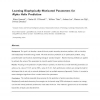Free Online Productivity Tools
i2Speak
i2Symbol
i2OCR
iTex2Img
iWeb2Print
iWeb2Shot
i2Type
iPdf2Split
iPdf2Merge
i2Bopomofo
i2Arabic
i2Style
i2Image
i2PDF
iLatex2Rtf
Sci2ools
BMCBI
2007
2007
Learning biophysically-motivated parameters for alpha helix prediction
Background: Our goal is to develop a state-of-the-art protein secondary structure predictor, with an intuitive and biophysically-motivated energy model. We treat structure prediction as an optimization problem, using parameterizable cost functions representing biological “pseudo-energies.” Machine learning methods are applied to estimate the values of the parameters to correctly predict known protein structures. Results: Focusing on the prediction of alpha helices in proteins, we show that a model with 302 parameters can achieve a Qα value of 77.6% and an SOVα value of 73.4%. Such performance numbers are among the best for techniques that do not rely on external databases (such as multiple sequence alignments). Further, it is easier to extract biological significance from a model with so few parameters. Conclusions: The method presented shows promise for the prediction of protein secondary structure. Biophysically-motivated elementary free-energies can be learned using SVM tech...
Biophysically-motivated Energy Model | BMCBI 2007 | Protein Secondary Structure | Secondary Structure Predictor |
Related Content
| Added | 12 Dec 2010 |
| Updated | 12 Dec 2010 |
| Type | Journal |
| Year | 2007 |
| Where | BMCBI |
| Authors | Blaise Gassend, Charles W. O'Donnell, William Thies, Andrew Lee, Marten van Dijk, Srinivas Devadas |
Comments (0)

